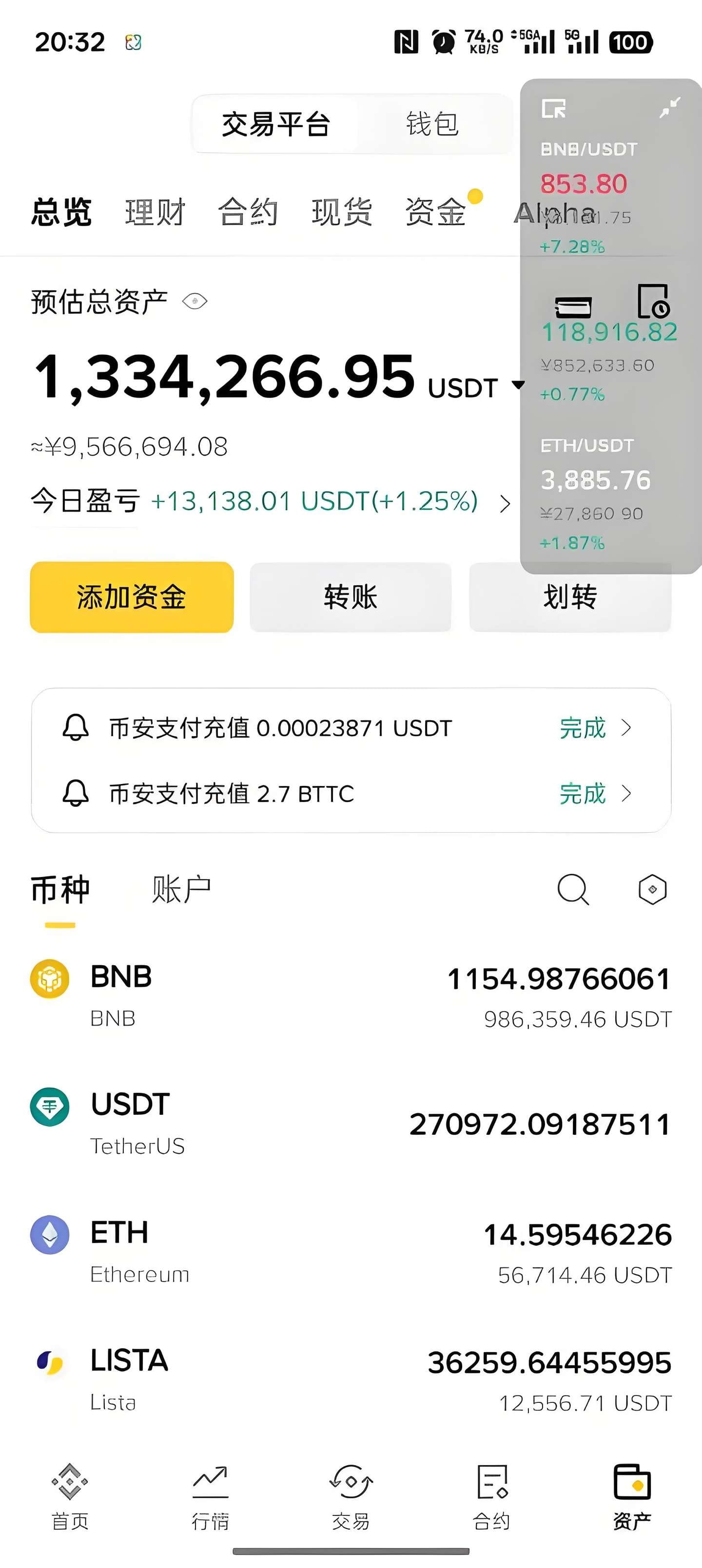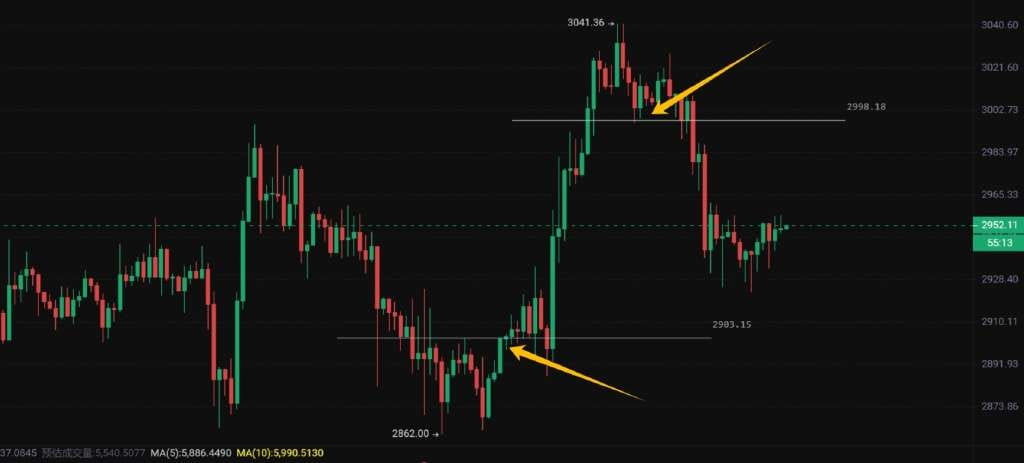A decade of honing a sword — the 'dumb method' logic from retail investor to eight-figure capital.
I entered the crypto world at 22, experienced over a decade of bull and bear market training, and after accumulating practical experience in various fields like stocks and futures, ultimately found the core logic of 'almost 100% profitability' in the cryptocurrency market — rejecting trades based on gut feelings, replacing gambling with discipline, and substituting random decisions with replicable strategies. In 2024-2025, relying on this 'dumb method', my capital size broke into eight figures.
The following 4 rules are the essence of practical experience I summarized from countless losses; each corresponds to real monetary lessons and gains.
7 core trading rules: full process coverage from improving win rates to risk control.
(I) Rule 1: The core of improving win rate — only trade 'with the trend', reject 'against the trend speculation'.

Core logic: 90% of losses in the crypto world come from 'bottom fishing against the trend', while the key to profit lies in 'buying low with the trend'. In a downtrend, all rebounds are traps (for example, during the 2024 bear market, BTC rebounded from $45,000 to $52,000, seemingly strong, but actually later fell to $38,000); in an uptrend, all pullbacks are 'golden pits' (in 2025, CFX pulled back from $0.27 to $0.18, which was a low-buying opportunity before the main surge).
Practical comparison: bottom fishing requires precise judgment of the 'bottom'; even a 10% error can lead to being trapped by over 30%; while low buying waits for pullbacks in an upward trend, for example, when the 3-day line turns upward, intervene near the 10-day moving average, increasing the win rate by at least 60%.
Key question: Would you rather gamble on the 'bottom' in a downtrend or earn 'certain profits' in an uptrend? The answer is obvious.
(II) Rule 2: Avoid traps — do not touch coins that experience 'short-term rapid surges'.

Underlying logic: whether it's mainstream coins (like ETH, SOL) or altcoins (like small-cap blockchain tokens), less than 5% can experience more than 2 major upward waves. A short-term surge (for instance, over 100% increase within 3 days) indicates that capital has taken large profits and exited; the momentum for further increases is extremely weak — during high-level stagnation, buying pressure cannot sustain, naturally leading to a sell-off.
Practical case: In May 2025, a certain Hong Kong concept altcoin X (anonymous) surged 80% in one day due to 'false cooperation news', but the next day, trading volume plummeted by 50%, followed by a 65% drop in 3 days, trapping countless chasing retail investors; in contrast, during the same period, CFX, although it was the leading Hong Kong concept, consistently maintained a strategy of 'steady increase + low buying during pullbacks', rising from $0.12 to $0.31 in 3 months, with no sudden spikes or drops, allowing investors ample exit opportunities.
Discipline requirement: as long as a coin’s daily increase exceeds 30% or 3-day increase exceeds 50%, immediately add it to the 'blacklist'; even if it continues to rise afterward, do not participate — opportunities in the crypto world are always there; missing one will not lead to losses, but stepping into one may lead to zero.
(III) Rule 3: Entry and exit point judgment — use MACD as a 'steady signal filter'.

Selection principle: only choose coins whose '30-day moving average is upward'; even if there is a favorable policy for coins below the 30-day line, do not participate — if the trend is wrong, efforts are in vain; instead of waiting for a rebound in a downtrend, it is better to profit easily in an uptrend.
(IV) Rule 4: Weekly Review — Use discipline to ensure the strategy does not deviate.

The core purpose of reviewing: to check whether the 'holding logic' and 'actual market trend' are consistent, timely adjust wrong decisions, and avoid small problems turning into large losses.
Review process (must do every Sunday night):

Logical review: revisit the buying logic of the held coin (e.g., policy-driven, upward trend) and assess whether the logic still holds (e.g., whether the policy has been implemented, whether the trend has changed).
Technical review: observe the weekly K-line trend — if the weekly K-line is still above the 30-week line and MACD is above the 0 axis, continue to hold; if the weekly K-line falls below the 30-week line or MACD forms a death cross, immediately reduce your position or stop loss.
Strategy adjustment: adjust next week's plan based on review results — for example, if a coin has achieved 50% profit and shows high-volume stagnation, plan to reduce the position by 50% next week; if a coin is still in the main upward wave, plan to add positions during pullbacks next week.
Practical value: In June 2025, the coin I held dropped below the 30-week line due to 'policy expectation delays'; through reviewing, I stopped losses in time and avoided a subsequent 25% drop; if I hadn't reviewed, I might have continued holding, leading to significant losses.
Summary: From 'gut feelings' to 'discipline' is the only path to profit.

The crypto world is not a casino but a 'battlefield of strategy and discipline' — I went from being a retail investor to managing eight-figure capital, relying not on 'luck' but on the strict implementation of these 7 rules. Remember:
Never trade based on gut feelings; each buy, sell, add, or stop loss must have clear indicator signals to support it.

Opportunities in the crypto world are always there; missing out is not scary; what is scary is stepping into traps due to greed or luck.
Insist on using the 'dumb method' — with the trend, don’t chase high, don’t average down, repeat trading; it seems slow, but in fact, it is the fastest path to profit.
Having experienced multiple bull and bear markets, I deeply understand that the 'wealth code' is never 'a secret to getting rich overnight', but rather 'the discipline of stable profits'. In the future, I will continue to share more practical experience to help more people avoid loss traps and seize truly valuable opportunities — don’t let 'gut feelings' destroy your funds; embracing profits with discipline is the only choice for long-term survival in the crypto world.

How to play short-term well?
The entire crypto market also goes up and down, experiencing despair in hope and welcoming hope in despair.
This is particularly anxiety-inducing for most people; this is the norm in financial markets, something everyone must experience and cannot avoid.
So don’t pay too much attention to current gains and losses, because the market continues; wins and losses have yet to be revealed. Of course, for those who are liquidated, they have already exited early.
Because you are not in the circle, this financial game in the crypto world has nothing to do with you.
So at all times, you must ensure you are alive; otherwise, no matter how good the opportunity is, it cannot change your fate.
Whether it’s contracts or spot trading, the core of making money lies in the trend: is it upward or downward? Only by buying in the right direction can there be profit.

The market that has already passed can only become history; the only thing that matters to us is the trends that have yet to happen, so the current focus is only on one thing: which direction will the subsequent market go.
If the trend is upward, naturally, you should firmly hold onto the spot or go long to profit; if downward, naturally, reduce your spot position and short on contracts.
However, there is one thing to note: that is the cycle; there is a fundamental difference between the big trend and the small trend.
The big trend brings returns of dozens of times; the small trend brings returns of several points.
Therefore, whether you choose spot or contracts, you must make decisions based on this understanding; otherwise, you are just gambling, chasing after rises, cutting losses when it falls, and living in constant fear, physically and mentally exhausted.

Short cycles are not difficult at all in the technical field; you just need to learn a little about naked K techniques and catch a dozen points in the market, basically with your eyes closed.
To trade short cycles, you only need to meet three conditions to basically guarantee profits.
First, be able to find support and resistance levels.
Secondly, sufficient patience to wait for market trends that you can understand.
Thirdly, have ample time to monitor the market and strictly execute stop losses and profit-taking.
For those who want to trade short-term, you only need to master one small trick to turn losses into profits easily.
As long as you keep practicing, short-term trading becomes a flow operation; when opportunities arise, execute according to the steps.
Super effective rolling position secret — the key to not blowing up in three months.
The truth of the crypto world: rolling the position correctly is a money printer; rolling it incorrectly is a money shredder. Last year, I rolled from 13,000 to 97,000 in 127 days, relying on these 3 stubborn rules.
1. Leverage must never be fully invested.

Many people think that 20x leverage can lead to overnight wealth, but in reality, a 3% fluctuation in BTC can lead to liquidation.
I have a formula: initial position = total capital × 3% ÷ (leverage × volatility).
For example, if BTC fluctuates 5% in a day, I would open a position of 1200 yuan with 5x leverage. Controlling position in this way helps to avoid total loss.
2. The way to break the death spiral.

LUNC surged 80% last December, and I started to increase my position 3 minutes before it broke the previous high.
Start with a 20% position, then add 10% after breaking +5%, add 5% after breaking +10%... for each layer added, the profit target increases by 3%, with the final 220% profit coming 90% from the third layer.
There are tricks to adding positions, but the entire logic behind it must be thoroughly considered.
3. Life-saving umbrella.

I set very strict stop losses for the rolling positions.
Initial stop loss = opening price × (1 - 1.5 × ATR).
When profits reach 50%, the stop loss will automatically move up to the cost price.
When it reaches 100%, start moving the stop loss; for every 2% increase, move up 1%.
Last week, my method achieved a 73% return on WIF.
Want to know how to lock in profits before a crash? This is the most critical point, but it's not so easy to get rich overnight.
This method does not require luck; it relies on precise execution and strategy.

I used the most 'foolish' method in the crypto world to achieve a tenfold return in 3 days; I am not lying to you!
Don’t criticize me; I really made a fortune using the 'dumbest' method.
In this crypto world full of techies and quants, my strategy is almost primitive — only looking at one indicator, only doing one direction, holding steady, yet I end up profiting and laughing last.
I have never studied finance, nor have I ever looked at K-lines. I’m too lazy to even consider those Martin grid hedges. Just like that, I made a fortune.
My approach is sincerely simple.
1. Follow the hot trends and buy strong coins in the spot market. Wherever the main force goes, I will follow.
2. Break yesterday's high point and go all in; position up, stop loss? Never heard of it.
3. If it goes up, do nothing; if it loses, add to the position; I write my profit target directly on the calendar, and when the time comes, I exit.
You might think this is crazy, right? Like a joke. But I tell you, I relied on this operation to grow my account from 10,000 USDT to 100,000 USDT; $DOGE surged 7 times, and $PEPE surged 3 times! I didn’t withdraw funds throughout, and I’m still earning.
Those who analyze every day, fake breakouts, fake signals, what did they do? They shook out and blew up, their mindset collapsed.
And my 'dumb method' ended up being the one that laughed last!
Many people cannot understand and criticize me in the comments: 'Isn’t this just gambling?'
Yes, I gambled. What I gambled on was the correct direction, not those unreliable air.
My principle is very simple:
Never short; only go long.
Do not touch coins that have no progress; only follow the hot trends.
Once you enter the market, hold steady.
Do not set stop losses; control drawdowns with funds.
Isn't it simple? But that's how it is; I took several fans along and rolled the position 4 times in one week!
So, if you are willing to listen and willing to adopt the 'dumbest' strategy, you can also make money!
Don't be afraid of lacking skills; what's scary is being overly smart and blowing up your mindset!
